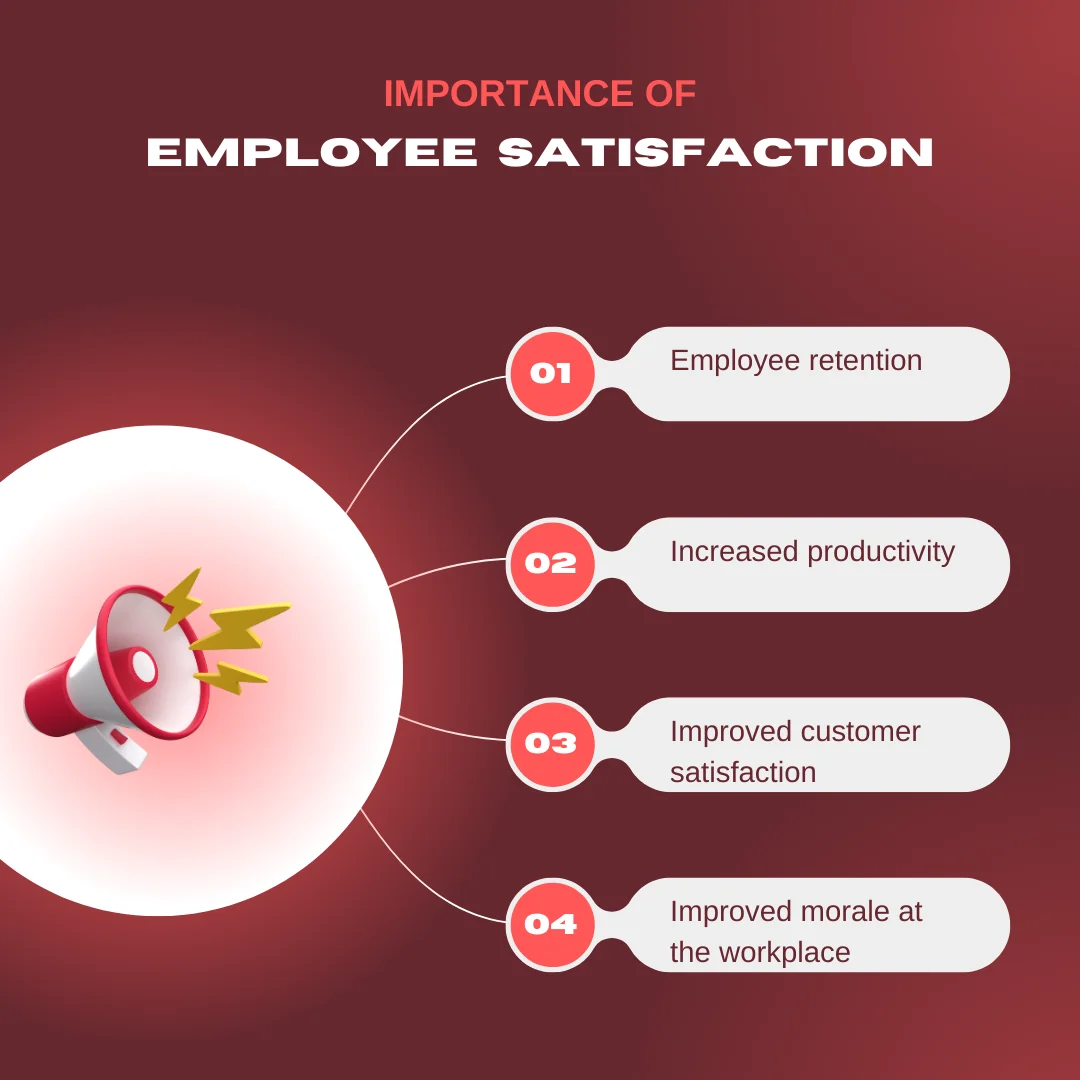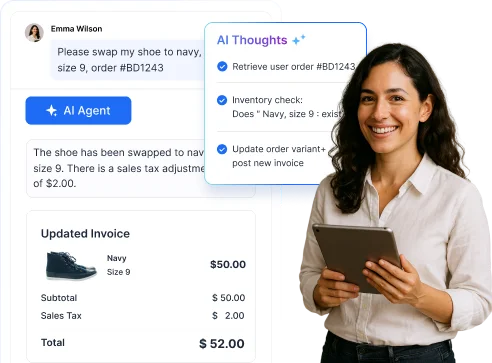Employee satisfaction forms the cornerstone of any company. A happy employee translates to a happy customer. If an employee is satisfied with the work conditions in the company, you will easily tell.
This is because they will offer the best customer service experience they can. For this reason, it should be every employer’s goal to ensure employee satisfaction is at its optimum level at all times in order to grow.
This blog guides you through different ways to improve employee satisfaction. In addition, you will learn what employee satisfaction means and why it is important to keep your employees happy.
What is employee satisfaction?
Employee satisfaction can be described as the level of fulfillment that employees feel while working at their organization, or how happy are they with their jobs.
When defining employee satisfaction, it is important to consider whether employees are happy and content.
A business’s success depends significantly on its ability to maintain a happy workforce, as contented workers are more likely to be innovative, dedicated, and productive.
Additionally, they are less likely to quit, lowering turnover rates and the expense of recruiting and onboarding new hires.
Why is employee satisfaction important?
Having employees who are happy or content working at your company is vital to ensuring its continued growth.

The following are reasons why it is important to strive to satisfy your employees:
Employee retention
To establish a good workplace culture, make sure all employees are well treated, taken care of, and that there are good relationships among your employees.
This creates a safe space for employees where they can work calmly and efficiently. The possibility of employees leaving for other companies is reduce.
Most people prefer to work in companies where they feel comfortable and happy, compared to places where they are paid well but unhappy.
After all, what is the use of getting good pay if you are depressed at the workplace?
Increased productivity
Providing your employees with all the resources they need to carry out their tasks improves their productivity.
In addition, when companies motivate their employees, they give their best performance at work.
Efforts like cultivating a positive and transparent work culture help boost teamwork. This eventually improves productivity.
Improved customer satisfaction
When employees are satisfied, their happiness and contentment translate to attending to their clients with the same sentiment.
They will provide service to clients well and interact with them in a friendly manner. They will deliver work that is high quality.
As a result, clients will be satisfied too due to the care they receive from these employees.
Improved morale at the workplace
Praising or recognizing employees when they perform well or achieve a milestone improves their morale and motivates them to keep doing great work.
This, in turn, increases the company’s profits and ensures continued growth.
How to improve employee satisfaction (11 tips)
Besides having compensation and benefits plans for your employees, there are other non-financial ways that can make boost employee satisfaction.
The following are some best practices to improve employee satisfaction:
1. Allow employees to take part in decision-making and feedback
Empower your employees by involving them in the process of making decisions on company policies that directly impact their work.
Get their opinion through regular meetings, discussions, and feedback. Listen to employees’ suggestions on ways to resolve problems affecting certain areas.
It shows the employees that the company cares about them and values their opinions.
This boosts their confidence in what they do and makes them feel more in charge of their work. It makes them more productive in the long run.
2. Acknowledge and celebrate employee achievements
Show appreciation to your employees when they reach certain milestones or accomplish big things at work. This can be done by:
Admit the employee during work meetings.
Offering small gifts like gift cards and holiday destination tickets.
Giving them days off to take a break from the hard work.
In addition, celebrate their personal achievements such as their work anniversaries and birthdays.
To acknowledge and celebrate your employees is a good gesture to show them that you appreciate and value their efforts.
It boosts their morale, makes them loyal to the company, and encourages them to keep being passionate at work.
It also encourages other employees to follow suit and improve their own work in order to get the same appreciation.
As a result, their job satisfaction will increase, as well as their overall productivity, and ultimately the company’s profits.
3. Offer a flexible work schedule
A PWC survey reveals that 62% of respondents favor a hybrid work model that integrates on-site and remote work.
The onset of the global pandemic, COVID-19, saw a major revolution in the workplace. Working from home became the most ideal option.
It led to an increase in hybrid and remote work, which has now become a new norm. Most companies prefer flexible work schedules that can accommodate employees’ specific working hours, regardless of their location.

Employees from different parts of the world in different time zones must work together to achieve the same company goal.
For this reason, companies should provide powerful communication tools for seamless interaction among all employees. Employees should feel like they are interacting in person and in the same physical office.
Flexibility helps improve the productivity of employees since they each have working hours that suit them.
4. Ensure a work-life balance for employees
Ciphr reports that a significant majority of remote workers, about 79%, prioritize work-life balance above all other job components. This is in notable contrast to those employees who engage in remote work on a part-time basis or not at all, of whom only 66% consider work-life balance to be of utmost importance.
It is employers’ responsibility to ensure their employees have a good balance between their work life and personal life. With well-defined working hours, employees can know when to stop working and focus on their personal life.
This balance helps employees to separate their personal time from working hours. As a result, employees are less stressed from overworking, which leads to higher job satisfaction.
The company can close the office when working hours elapse in order to encourage employees to leave and go do anything else.
5. Encourage and provide learning and development opportunities
Defining a skills road map is the first step to enhance the abilities of an employee.
With one in place, you then need to provide the learning and development resources they need to help them fulfill their positions to their maximum potential.
There are many resources you can rely on to help your employees develop in their careers.
For instance, you can offer short training sessions for employees to learn some new skills. You can also provide an online learning hub for your employees to access and learn from.
In the learning hub, include all the necessary learning tools and content that you can afford and access.
You can also offer short online courses in the learning hub. In addition, you can offer flexible work schedules for employees who are pursuing further studies as a gesture of encouragement.
6. Have a clear path for career growth for each employee
It is important to give your employees the opportunity to grow professionally.
Provide individual employees with a well-defined road map on the new skills they need to learn to advance in their careers.
Outline the abilities they should develop to perform better in their current positions and in potential future positions they may qualify for.
Supporting your employees’ career journey goes a long way to ensure higher productivity on their end. In addition, employees appreciate the effort and stay loyal to the company.
Knowing that you care about their future advancement gives them a sense of satisfaction.
7. Build a positive and transparent work culture
With a company that fosters a positive and transparent work culture, employees communicate, speak their mind, and share their ideas with confidence.
Every employee is listened to and encouraged to give their opinions on any aspect that affects them at work.
They are free to discuss new ideas that are likely to play some part in running the company.
On the other hand, the company should be transparent with its employees and communicate any updates.
For instance, you can hold regular company meetings to provide updates on the progress of each department and the company as a whole.
Share the company’s vision and goals with employees. Let them know the policies they need to uphold as well.

Such an open environment in the workplace motivates employees to be more productive because they are comfortable at work.
Being heard gives them a sense of satisfaction and keeps them loyal to the company. It becomes a place they enjoy being at.
8. Do not micromanage your employees
Employees thrive when they are given the chance to grow and achieve their goals under minimal interference from their leads or managers.
Giving employees clear guidelines that define their roles and responsibilities should be enough.
If you nag your employees over every minor task, they are likely to become stressed, frustrated, and unhappy. Allow them to work with less supervision in order to boost employee satisfaction.
Companies have to avoid asserting aggressive authority over employees. If team leads or managers tell employees how to do their jobs, employees are likely to feel demotivated, untrusted, and may opt to leave the company.
When employees are micromanaged, they tend to lose morale and become less productive. It also leaves them burned out from too much pressure, and thus dissatisfied with their work.
9. Encourage social interaction among employees
Most employees feel more comfortable in a workplace with friendly people. It is advisable for companies to encourage their employees to socialize with each other.
To encourage interaction, a company can organize social events like annual company dinners or quarterly gatherings. They can also have team-building events such as sports competitions.
An interactive workplace fosters good communication and makes employees familiar with each other.
Good relationships at work make employees more productive as they join forces to achieve the common company goal.
It also becomes easy for employees to sort out any conflicts among themselves that may hinder important achievements.
For remote workers, good communication tools should be provided so that they can be an integral part of the company. These practices promote employee engagement as well as employee satisfaction.
10. Provide ergonomic office tools
A great way to make employees more efficient is by providing them with tools and resources that will ease their efforts and reduce manual work.
These tools can be in the form of software or hardware.
For instance, a company can provide its employees with good quality communication software and hardware so they can interact seamlessly.
The company can also offer technical software to automate tasks that are hard and time-consuming.
Ergonomic tools promote efficiency. They reduce the effort and time spent by employees to perform tasks, thus improving their productivity.
They also increase employee satisfaction since they make employees feel that their employer cares about their well-being.
Ultimately, this boosts employee retention since they are comfortable at their workplace.
11. Create an internal help center
An internal help center is a centralized location where employees can access company information and instructions on how to troubleshoot common issues.
Establish an internal help center, such as a comprehensive knowledge base to:
- Empower employees to find solutions independently.
- Save time.
- Improve employee productivity.
- Create a more positive work experience.
Additionally, internal help resources can serve as a platform for continuous learning and development.
By including training materials, best practices, and troubleshooting guides, companies can allow their employees to expand their skills and knowledge at their own pace.
This investment in their professional growth demonstrates that the organization values their development, which can boost morale and job satisfaction.
How to measure employee satisfaction in the work environment
Understand morale, identify areas for improvement, and foster a positive workplace culture by measuring and analyzing employee satisfaction in the work environment.
Surveys
Conduct regular employee satisfaction surveys using both quantitative and qualitative questions. Include topics such as job satisfaction, work-life balance, career growth opportunities, compensation, benefits, and satisfaction with leadership.
Employee net promoter score (eNPS)
This metric measures employee loyalty and willingness to recommend the company as a workplace to others. A simple survey asks employees how likely they are (on a scale of 0–10) to recommend the company to a friend or colleague. Based on their response, employees are categorized as promoters (9-10, satisfied and loyal), passives (7-8, neutral), or detractors (0–6, dissatisfied).
The eNPS is determined by subtracting the percent of detractors from the percent of promoters. The resulting score can range from -100 to 100, with higher scores indicating higher levels of employee satisfaction. A positive eNPS indicates that the majority of employees are satisfied and likely to recommend the company, while a negative score suggests that there may be underlying issues affecting employee morale.

One-on-one meetings
Schedule regular one-on-one meetings between employees and their managers to discuss their experiences, concerns, career goals, and overall satisfaction. These confidential conversations allow for open dialogue and personalized support.
Focus groups
Organize focus groups comprising small groups of employees from different departments or levels within the organization. Facilitate discussions on various aspects of the work environment to gain deeper insights and diverse perspectives.
Exit interviews
Conduct exit interviews with departing employees to gauge and understand their reasons for leaving, gather feedback on their experiences, and identify areas for improvement. Analyze trends in exit interview data to address underlying issues and reduce turnover.
Performance self-reviews
Evaluate whether employees feel valued, recognized, and adequately supported in their roles. Performance self-reviews can provide insight into employee morale and engagement. Look for signs of discouragement, lack of motivation, or declining performance that might be linked to dissatisfaction.
Challenges in measuring employee satisfaction metrics
The process of measuring employee satisfaction comes with its own set of challenges. Understanding these challenges can help organizations refine their approach and gather more accurate data.
Selecting the right tools and methods
Organizations must choose appropriate tools and methods for measuring satisfaction. Surveys are common, but the questions must be carefully crafted to obtain clear, actionable feedback. Other methods might include interviews, focus groups, and observation, each with its own limitations.
Ensuring anonymity and confidentiality
Employees may not provide honest feedback if they fear consequences. Ensuring anonymity and confidentiality on surveys is essential to gather genuine responses, but it can be difficult to maintain, especially in smaller organizations.
Response bias
Response bias can occur when employees feel pressured to provide positive feedback or when they respond based on what they think the organization wants to hear. This can twist results and provide an inaccurate picture of satisfaction.
Cultural differences
In global organizations, cultural differences can affect how satisfaction is expressed and measured. What indicates satisfaction in one culture may not in another, making it difficult to create a one-size-fits-all approach.
Frequency and timing
Deciding on how often to measure employee satisfaction is a challenge. Too frequent, and it can lead to survey fatigue; too infrequent, and the organization might miss important shifts in employee sentiment.
Conclusion
Employee satisfaction is the key to any company’s growth. With best practices in place to improve employee satisfaction, they become more productive.
They also have higher morale, and remain loyal to the company. This then translates to satisfied customers in the long run.
With BoldDesk, give your employees the best help desk experience and satisfaction. Try the BoldDesk free trial for your employees to thrive. Contact the BoldDesk support team if you have any questions.
You are welcome to schedule a 30-minute live demo to experience the system firsthand.
Related articles



















 Email Ticketing System
Email Ticketing System Shared Inbox Software
Shared Inbox Software Multi Brand Help Desk
Multi Brand Help Desk Internal Help Desk Software
Internal Help Desk Software Trouble Ticketing Software
Trouble Ticketing Software Mobile Help Desk
Mobile Help Desk 
















